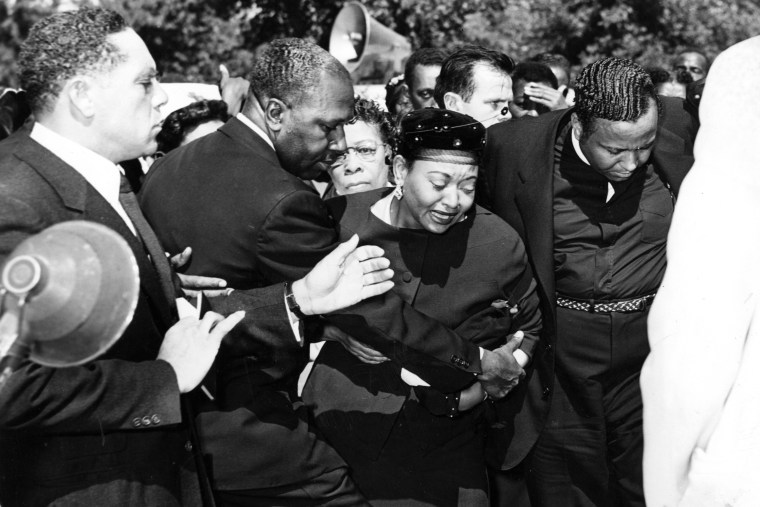Familiarity breeds contempt.
For two weeks now, as we’ve watched the events in Ferguson, Missouri unfold, there’s been a vulgar familiarity about them. The grieving family, the protesters, the police in gas masks and military garb: They all seemed locked into a story as old as America itself. It is the story of implicit bias, black pain, disenfranchised communities and systemic racism.
"The grieving family, the protesters, the police in gas masks and military garb: All seem locked into a story as old as America itself."'
Eighteen-year-old Michael Brown was killed by a police officer when he was stopped for walking in the middle of a street. Witnesses say Brown put his hands up and said “Don’t shoot” to Officer Darren Wilson. The police, however, have remained quiet on Wilson’s version of events, choosing instead to make the victim the focus by releasing grainy video footage of the teen allegedly haranguing a store keeper over a pack of pilfered cigars.
It’s all too familiar, from the blaming of the victim to the community outcry, and is yet another example of how this nation has long devalued the lives of its black citizens. Instead of trust and healing, the streets of Ferguson were full of tear gas and militarized police. In the place of justice, there is only anger, reminiscent of scenes we have seen before.
Fifty-nine years ago this week, 14-year-old Emmett Till was murdered for allegedly “whistling” at a white woman. His death and open-casket funeral revealing the boy’s brutalized body caused a national outcry, demonstrating how African Americans were viewed as less than human in many parts of our society, and that those who kill them would likely go unpunished.
"Michael Brown is now part of a tragic legacy."'
But the killings of Emmett Till and those like him, for infractions small or imagined, didn’t start 59 years ago. These killings and the divide they illustrate are rooted in 400 years of oppression.
Michael Brown is now part of a tragic legacy, a member of a group that includes Till. You’ll also find Trayvon Martin there, killed last year by a self-appointed neighborhood watchman who stalked him as he walked home. You’ll find New Yorker Eric Garner, choked to death by police last month for asking why he was being harassed. There’s John Crawford, killed by police the same week as Brown for holding an air rifle – essentially a toy gun – in an Ohio Wal-Mart. Ezell Ford’s death this month either came from resisting arrest or lying face down in the street, depending on whether you believe the Los Angeles police or Ford’s mother.
A 2012 study revealed that police officers, security guards, or self-appointed vigilantes extra-judicially killed at least 313 African Americans that year alone. This means a black person was killed at the hands of a “security” officer every 28 hours. But these dire fates are not inevitable. They are the result of generations of suppression and inequality, devaluing the lives of African Americans to the point where we invest little in economic equality, education and the other types of policies that create opportunity in other parts of America.
"In Ferguson and other towns across America, the keys are community policing and political empowerment."'
In Ferguson and other towns across America, the keys are community policing and political empowerment. Ferguson is more than 60% African-American, yet only three out of the police force’s 50 officers are black. Ferguson’s city government is also mostly white, with only one black council member. The anguish of Ferguson is partially explained by the system its residents have been living under – a political and law enforcement structure that neither reflects nor represents them.
The police should protect and serve all people, yet for too many communities of color, police are an occupying force using suppression-only tactics, indicting residents by the color of their skin, not differentiating between them and the criminal element they seek. Police departments must reflect the communities they serve and hire people willing and able to interact, partner, communicate and problem-solve with the community. Hiring practices, building trust and relationships with communities and proper training are paramount to preventing such horrific incidents and increasing public safety. To solidify these changes, the community must engage and organize, both with its leaders and in the process of electing and holding those leaders accountable.
We don’t have to accept the hand that has been dealt to us by systemic racism. We can pledge to make this story far less common, and refuse to remain familiar with the controlling structure of fear.
Gov. Ted Strickland was the 68th Governor of the State of Ohio, and now serves as president of the Center for American Progress Action Fund.
Judith Browne Dianis is a veteran civil rights attorney, and serves as Co-Director of the national racial justice organization Advancement Project.
